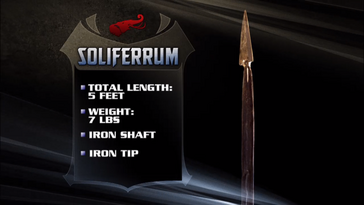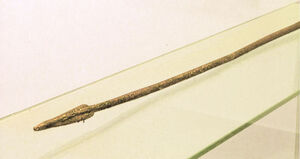
A Soliferrum

The Soliferrum (from Latin solos, "only" + ferrum, "iron") is an Iberian throwing spear. It was the Medium-Range weapon of Hannibal Barca.
Stats[]
- Total Length: 5 feet
- Weight: 7 lbs
- Iron shaft
- Iron tip
Description[]
The soliferreum was a heavy javelin forged from a single piece of iron, and was usually 1.5 to 2 meters in length. The barbed spear tip was narrow so as to pierce through shields and armor: which would be complemented by the weight of the full iron javelin.
Uses[]
Like other javelins, the soliferrum was thrown in volleys to disorganize the enemy formation before advancing for close quarters combat. It could also be thrown from horseback, as shown in the test. The weight and density of the weapon's iron shaft, coupled with the narrow tip gave it excellent armor-piercing capability at close range.
History[]
The Sintashta were the first known people to use chariots. They did have a variety of javelin designs, many of which were likely used from their chariots.
Soliferrum and similar Javelins were common across the Mediterranean Sea due to how cheap the weapon was to make. Numidian Calvary were considered to be the deadliest horsemen used by Carthage thanks to their effective use of the Soliferrum. Numidians relied on using light equipment and little or no armor to outmaneuver their foes with superior speed; this did make them ineffective against heavy infantry in close combat, but using javelins at a distance could still be effective even against Roman Legionnaires. Hannibal Barca used these mercenaries effectively to defeat Roman cavalry units and then outflank the Roman legions; most noticably in the Battle of Cannae. However the Romans also hired Numidians as well and used them to match Hannibal's mercenaries. North Africa would continue to see similar light cavalry units throughout its history.
Roman Cavalry would adopt the Soliferrum and light Lancea from their enemies. Most Roman horsemen would carry up to three of these javelins at a time.
The Roman Pilum was heavily inspired by the Soliferrum. The Pilum used a wooden shaft in order for the Pilum to still function as a spear if necessary; something that a thin dart like the Soliferrum cannot do. The Pilum also had an intentionally frail wooden pin holding the spearhead to make the Pilum break when thrown; making it impossible for an enemy to reuse the weapon (a potential weakness in the mass produced and sturdy Soliferrum).
Horse Archery, made infamous by Attila the Hun, had superior range and mobility than javelin cavalry. Medieval armor technology also advanced to a point where light javelins became less relevant in warfare. A noticeable exception were the Jinetes; Catholic cavalry units from the Iberian Peninsula. The reason why Jinetes were so successful was because their most common opponent, the Moors, used primarily lightly armored troops.
The Qing Dynasty was one of the last empires in the world to use javelins from horseback.
Test[]
The Soliferrum was pitted against the Jida Lance of Genghis Khan for mid range weapons. The two weapons were tested in eliminating a moving target from horseback. Neither weapon achieved an instant kill, but the edge was given to the soliferrum due to the fact it could be used as a missle weapon and Hannibal would be carrying multiple soliferrums.
Trivia[]
- Celtiberians respected the effectiveness of the Soliferrum so much that their warriors that died in battle while still possessing their Soliferrum were buried with their javelin.
- Documentary on the Soliferrum: [1]
- Percentage wise, the Soliferrum is the most successful weapon in any category of season 3. It scored 86% as Hannibal's mid-range weapon in the simulation.